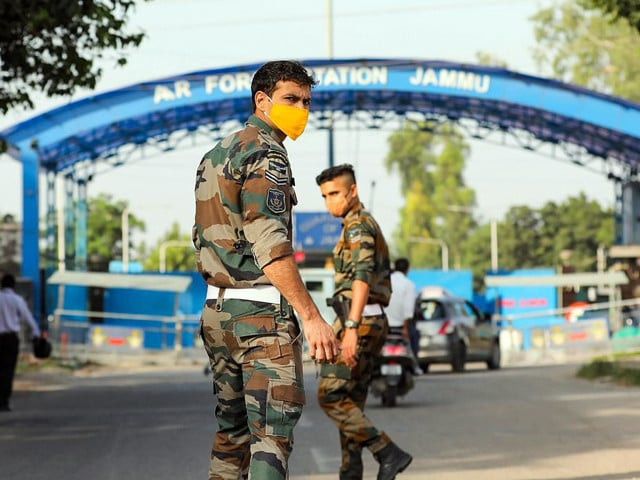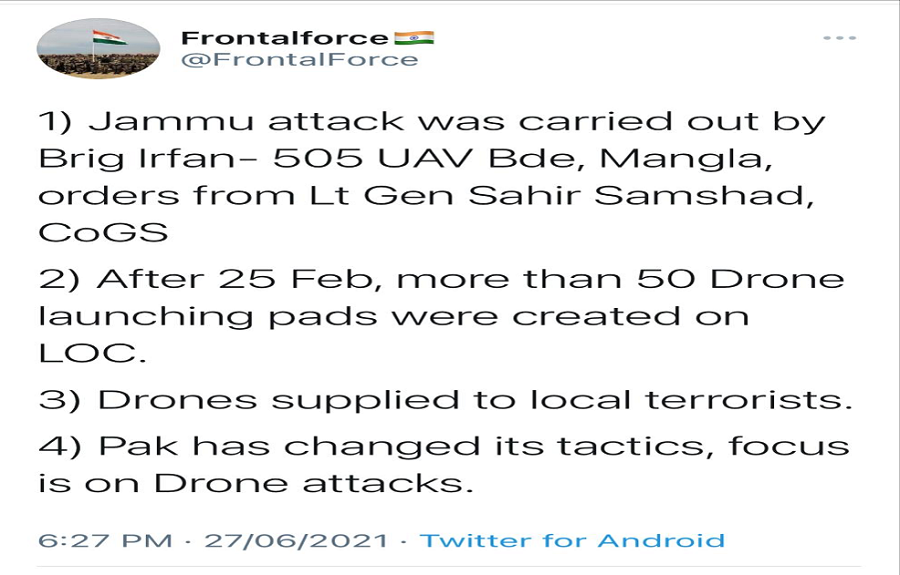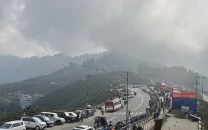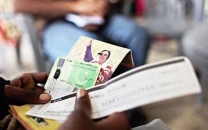Another misstep: Delhi’s drone drama debunked
Analysts dismiss ‘choreographed quadcopter attack’ in IIOJK as an attempt by India to achieve several strategic goals

The Indian attempts to blame Pakistan for what appears to be a choreographed “drone attack” on an air force base in Jammu city of Indian Illegally Occupied Jammu and Kashmir (IIOJK) have fallen flat as the entire drama began to unravel.
The “drone stunt” is consistent with previous Indian attempts to stage false flag operations as part of its strategy to take the spotlight off its internal issues, to malign Pakistan globally, and to discredit an indigenous freedom movement in IIOJK that it has failed to quell.
Senior analysts, who have examined the supposed evidence, statements, and media coverage from the other side of the border, believe that India’s latest attempt to blame Pakistan has failed miserably on all fronts. New Delhi’s reputation, they say, has taken another drubbing after it was unable to present evidence to substantiate its claims.
When reviewed the sequence of events that followed the “drone stunt” on June 27, it transpired that New Delhi was aiming to pin the blame on Islamabad, even before an investigation was launched.
 The Frontalforce, an account that claims to be reporting on conflicts and current affairs has deleted the post
The Frontalforce, an account that claims to be reporting on conflicts and current affairs has deleted the post
Moments after the incident, Dilbagh Singh, the local police chief, came out accusing “Pakistan-based terror groups” of the attack. Within hours, Mukesh Singh, the additional director of police, parroted the same line, adding that it was an attempt to disrupt the political process in IIOJK.
While these statements were being amplified, and the Indian government claimed that the “explosions” were so intense that they could be heard within a radius of two kilometres, the media pulled the plug on the narrative by reporting no blast was heard and no flying object was seen over the area.
From this point on, the Indian government intensified its efforts to weave a narrative that portrayed Pakistan as the sole aggressor and projected the incident as a repeat of the 2016 Pathankot attack.
Such low intensity blasts are almost always trial runs to test penetration, signal links, blast effects, ground prep/response etc. Indian & Pak forces routinely use quadcopters for surveillance. But this is the first time that Pakistan/Pak-backed groups have used it deliver IEDs. pic.twitter.com/kvu1GkJ4H1
— Shiv Aroor (@ShivAroor) June 27, 2021
A series of tweets from the Indian defence minister and the air force accounts further show how the investigation, which so far has revealed no evidence, was being shaped in a manner that paints Pakistan in a negative light.
Raksha Mantri Shri @rajnathsingh spoke to Vice Air Chief, Air Marshal HS Arora regarding today’s incident at Air Force Station in Jammu. Air Marshal Vikram Singh is reaching Jammu to take stock of the situation.
— रक्षा मंत्री कार्यालय/ RMO India (@DefenceMinIndia) June 27, 2021
Two low intensity explosions were reported early Sunday morning in the technical area of Jammu Air Force Station. One caused minor damage to the roof of a building while the other exploded in an open area.
— Indian Air Force (@IAF_MCC) June 27, 2021
Media reports from Delhi said the government had instructed the National Investigation Agency to prepare a dossier like one made after the Pulwama attack and then BJP leaders went on a tirade against Islamabad.
NIA is yet to take over the probe, but looks like “NIA sources” have already told one of the pro-Indian government media channels that the drones in Jammu “came from Pakistan”. Very Naughty. https://t.co/uLH0ge9jLx
— Kashmir Intel (@kashmirosint) June 27, 2021
While the probe is still under way, Union Minister of State for Home affairs G Kishan Reddy declared that Pakistan's role cannot be denied in the attack that was orchestrated through drones.
Without presenting any evidence, the minister then went on to say: “Pakistan is dropping AK-47s and drugs inside the border at night-time through drones. Our security forces have stopped many drones from entering the Indian side. Drones seen inside our land have been destroyed.”
The minister’s claims of the destroyed drone have not been substantiated by the Indian government.
The events in the run-up to the so-called drone attack are telling. On June 23, a bomb went off in the proximity of JuD chief Hafiz Saeed’s residence in Lahore.
The next day, India’s national security advisor says at a meeting of the Shanghai Cooperation Organisation (SCO) that “there is a need to monitor new techniques used by terrorists, including drones for smuggling of weapons and misuse of the dark web, artificial intelligence, block chain and social media”.
Within days of the said incident, on June 29, the Indian government also took its case to the UNGA. “Weaponised drones are being used for terrorist purposes against strategic and commercial assets,” Delhi told the main deliberative, policy-making, and representative organ of the United Nations.
For the Modi government, the campaign did not end at the UNGA. On June 30, roughly three days after the attack, Delhi directed the National Security Guard (NSG) to deploy an anti-drone system at Jammu airbase – the system is a combination of a radio frequency detector and soft jammers.
Top security and foreign policy experts who have analysed Delhi’s behaviour during this latest episode, say the Modi government appears to have orchestrated the attack to achieve several strategic goals.
“Let’s assume the attack took place. Drone technology used by militaries is very sophisticated and they can create casualties. The technology, we have been told was used, is commonly available and accessible to anyone,” said senior defense analyst Maj Gen (retd) Inamul Haq.
In the wake of the June 26 incident, India’s security agencies have claimed that seven unmanned aerial vehicles have been spotted hovering over military stations in Jammu. The narrative and the threat, Gen Haq said, was being amplified to build a case for India to expedite the induction of niche technologies, without the bureaucratic hurdles it faced when it cut the controversial deal to acquire Rafale jets built by France’s Dassault. The multi-billion-dollar deal has long been mired in corruption allegations and the prime minister remains at the centre of the scandal.
“When you connect the dots, India appears to be the sole beneficiary in this episode. Whether it is the victim syndrome or anything else, there is only one beneficiary – and that is India,” he said.
“India needs this distraction for domestic consumption, and it needs it for the international audience to support its narrative against Pakistan,” explained Gen Haq. However, he said that the international audience appears to be fatigued with India’s repeated attempts to paint Pakistan as a rogue state.
Value of the narrative
According to Dr Talat Wizarat, a noted scholar of International Relations, India’s reputation and credibility have taken a serious hit due to its repeated attempts to paint Pakistan as a country that exports terrorism. “New Delhi is an expert at weaving this narrative and conducting false flag operations.”
The so-called attack on the air force base, she said, has been choreographed in the way that it maligns Pakistan’s reputation. “Are we surprised about the timing? It is a deliberate attempt to paint Pakistan in a negative light and sabotage our chances of getting off the Financial Action Task Force grey list,” she explained.
Despite making progress on 26 out of 27 items of the financial watchdog’s action plan, Pakistan was kept on the increased monitoring list following a five-day plenary meeting last month.
“Don’t forget that Western countries are also trying to corner Pakistan for its alliance with China. They want to impose economic sanctions and India’s narrative is a perfect fit for their playbook,” said Dr Wizarat.
Dr Wizarat said India’s narrative kills more than one bird. “On the domestic front, Modi has failed completely in controlling the pandemic, the country’s economy is collapsing, and the prime minister wants to suppress any chances of peace in Kashmir,” she said.
The Indian prime minister, she explained, is going to use the attack to suppress political support for the restoration of Article 370, a 70-year-old provision that had given some autonomy to the state of Jammu and Kashmir.
“The trouble with Modi’s mind-set is that he feels that he can gain mileage by amplifying the threat from Pakistan. I am beginning to feel that this gimmick may not work anymore. My advice to Modi is to act like a responsible leader, invest India’s resources in controlling the pandemic, and the free fall of the country’s economy.”
Modi, the foreign policy expert said, needs to look inwards and that will help him gain some political mileage at home. “Focusing his energies on maligning Pakistan’s reputation or hurting Pakistan’s soft image will not help the Indian leader who is struggling for his political survival,” cautioned Dr Wizarat.
FATF pressure
For as long as Prime Minister Modi has been in power, Delhi has been trying to hammer Islamabad’s soft image. By creating a particular profile of its nuclear neighbour, India aims to isolate Pakistan in the region and at all global forums. So far, experts say, that hasn’t happened.
Delhi, according to Dr Shahida Wizarat, Dean College of Economics and Social Development, Institute of Business Management, is doing someone’s bidding in the region. “The West needs a reason to keep Pakistan under pressure and India continues to provide them with that reason by accusing us of terrorism.”
However, she said, even in the West there is a growing debate about the credibility of these claims by Delhi. Based on flimsy evidence, these actions, she said, are aimed to put Pakistan in a defensive position.
“By keeping Pakistan on the FATF grey list, they keep the pressure on us. If Pakistan makes it to the whitelist, then that pressure is released and if we end up being on the blacklist, the West will have nothing to use against us,” she explained.



















COMMENTS
Comments are moderated and generally will be posted if they are on-topic and not abusive.
For more information, please see our Comments FAQ